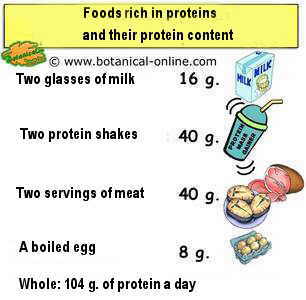Contents
RDA of vitamin A
Recommended daily allowance (RDA) of vitamin A
The necessary daily intake (RDA) of this vitamin is 4500 for men IU and 3500 IU for women.
These doses may vary according to age, sex or other special needs. For example, people with ulcerative colitis, Crohn’s disease, pancreatitis, liver disease, etc.. use to present an intestinal vitamin A malabsorption.
Other people exhibit additional needs, such as women with abundant menstruation, pregnant women, etc. All of them may require additional doses of this vitamin
The following chart shows how the daily dose can vary according to sex, age, pregnancy or lactation parameters:
Recommended daily allowance (RDA) of vitamin A In RAEs. (1 RAE = 1 μg retinol, 24 μg α-carotene, 12 μg β-carotene, 24μg β-cryptoxanthin) (According to the USDA for 2009) | |
| Children aged 1-3 | |
| Men | Women |
| 300 mcg (μg/d) | 300 mcg (μg/d) |
| Children aged 4-8 | |
| Men | Women |
| 400 mcg (μg/d) | 400 mcg (μg/d) |
| Children aged 9-13 | |
| Men | Women |
| 600 mcg (μg/d) | 600 mcg (μg/d) |
| People aged 14-18 | |
| Men | Women |
| 900 mcg (μg/d) | 700 mcg (μg/d) |
| People aged 19-30 | |
| Men | Women |
| 900 mcg (μg/d) | 700 mcg (μg/d) |
| People aged 31-51 | |
| Men | Women |
| 900 mcg (μg/d) | 700 mcg (μg/d) |
| People old(μg/d) than 51 | |
| Men | Women |
| 900 mcg (μg/d) | 700 mcg (μg/d) |
| Pregnant women aged 18 or young(μg/d) |
| 750 mcg (μg/d) |
| Pregnant women aged 19 or old(μg/d) |
| 770 mcg (μg/d) |
| Lactating women aged 18 or young(μg/d) |
| 1200 mcg (μg/d) |
| Lactating women aged 19 or old(μg/d) |
| 1300 mcg (μg/d) |
Tolerable Upper Intake Levels (ULs) of vitamin A (according to the USDA for 2009) | |
| Children aged 1-3 | |
| Men | Women |
| 600 mcg (μg/d) | 600 mcg (μg/d) |
| Children aged 4-8 | |
| Men | Women |
| 900 mcg (μg/d) | 900 mcg (μg/d) |
| Children aged 9-13 | |
| Men | Women |
| 1700 mcg (μg/d) | 1700 mcg (μg/d) |
| People aged 14-18 | |
| Men | Women |
| 2800 mcg (μg/d) | 2800 mcg (μg/d) |
| People aged 19-30 | |
| Men | Women |
| 3000 mcg (μg/d) | 3000 mcg (μg/d) |
| People aged 31-51 | |
| Men | Women |
| 3000 mcg (μg/d) | 3000 mcg (μg/d) |
| People old(μg/d) than 51 | |
| Men | Women |
| 3000 mcg (μg/d) | 3000 mcg (μg/d) |
| Pregnant women aged 18 or young(μg/d) |
| 2800 mcg (μg/d) |
| Pregnant women aged 19 or older (μg/d) |
| 3000 mcg (μg/d) |
| Lactating women aged 18 or young(μg/d) |
| 2800 mcg (μg/d) |
| Lactating women aged 19 or old(μg/d) |
| 2800 mcg (μg/d) |
Special needs of vitamin A
Sometimes, a special intake of vitamin A should be taken into account. In this case more vitamin A containing foods to should be eaten to reach the adequate amount or, in accordance with the doctor, vitamin A supplements can be taken. The usual intake of vitamin A could be increased in the following cases:
- Pregnancy
- Lactation
- Smoking or ingesting drugs: Because they have a oxidant activity and attack vitamin A.
- Intestinal diseases which favor vitamin A malabsorption (ulcerative colitis, Crohn’s disease, pancreatitis, liver diseases, etc)
- Inadequate diet: Either people who do not eat enough vegetables, fruits or animal food containing vitamin A or people who usually undertake low-fat diets (Vitamin A is a fat-soluble vitamin and needs fat to be absorbed)
- Zinc deficiency: Zinc is necessary to synthesize vitamin A
Although additional supplementation of vitamin A may be necessary in this cases, one should never exceed the Recommended daily allowance (RDA) since vitamin A abuse can be very harmful, especially when it is done by Vitamin A supplements. This is especial applied to pregnant and breastfeeding women. The excess of this vitamin can affect the fetus or the baby.
![]() More information about vitamin A.
More information about vitamin A.








